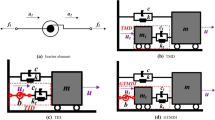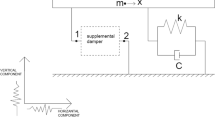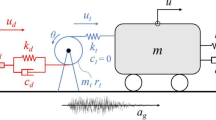Abstract
Compared with classical tuned mass damper (TMD), inerter system has higher damping efficiency and wider vibration control range. The traditional fixed-point theory of TMD have been used in most of the previous optimal parameter designs of inerter system, the optimized parameters obtained are expressed by the inerter-mass ratio, which may not be applicable to some specific inerter systems (such as tuned viscous mass damper, TVMD) or are too cumbersome. In this paper, the optimal parameters of the inerter system based on the characteristics of the grounded element and muti-performances demand are derived, and demand-based global optimal methods of the design parameters of the inerter system are proposed and compared. The correctness, feasibility and applicability of methods are verified by optimization examples and typical excitation including ground motions. The optimal parameters combinations of the inerter system derived based on the grounded element exist unique analytical expressions. When the value of the grounded element and the objective function are determined, the local optimal design of the inerter system can be realized. If the precise displacement vibration control of original structure is needed, the optimal parameters obtained by the stochastic displacement response that is taken as the objective function can be selected. If the demand is that total energy input of original structure requires is minimum, and the requirements for small displacement control effect are not strict, the optimal parameters of the inerter system obtained by the stochastic velocity response can be selected. If it is necessary to minimize the engineering cost and the control the peak and RMS displacement at the mean time, the optimal parameters of the inerter system obtained by deformation enhancement coefficient of damping element can be selected. The analytical expressions of the optimal design parameters of the inerter system based on the grounded element are concise and the processes of optimal design based on multiple performances objectives are simple, which can be applied to a variety of demands in practical engineering.
























Similar content being viewed by others
References
Araz, O., Elias, S., Kablan, F.: Seismic-induced vibration control of a multi-story building with double tuned mass dampers considering soil-structure interaction. Soil Dynam. Earthq. Eng. 166, 107765 (2023)
Araz, O.: Optimization of three-element tuned mass damper based on minimization of the acceleration transfer function for seismically excited structures. J Braz. Soc. Mech. Sci. Eng. 44, 459 (2022)
Araz, O., Farsangi, E.N.: Optimum tuned tandem mass dampers for suppressing seismic-induced vibrations considering soil-structure interaction. Structures 52, 1146–1159 (2023)
Araz, O., Ozturk, K.F., Cakir, T.: Effect of different objective functions on control performance of tuned mass damper for a high-rise building considering soil–structure interaction. Arch. Appl. Mech. 92, 1413–1429 (2022)
Araz, O., Cakir, T., Ozturk, K.F.: Effect of earthquake frequency content on seismic-induced vibration control of structures equipped with tuned mass damper. J Braz. Soc. Mech. Sci. Eng. 44, 584 (2022)
Araz, O., Cakir, T., Ozturk, K.F., Kaya, D.: Effect of foundation embedment ratio in suppressing seismic-induced vibrations using optimum tuned mass damper. Soil Dynam. Earthq. Eng. 171, 107981 (2023)
Araz, O., Kahya, V.: Design of series tuned mass dampers for seismic control of structures using simulated annealing algorithm. Arch. Appl. Mech. 91, 4343–4359 (2021)
Araz, O.: Optimization of tuned mass damper inerter for a high-rise building considering soil-structure interaction. Arch. Appl. Mech. 92, 2951–2971 (2022)
Zhang, R., Huang, J. & Zhang, Y. Dual-Demand-Based Optimal Design of Grounded Tuned Mass Damper Inerter for Seismic Response Mitigation. J. Vib. Eng. Technol. (2023).
Zhang, R., Huang, J., Cao, M., Luo, Q., Guo, X.: Study on parameters’ influence and optimal design of tuned inerter dampers for seismic response mitigation. Buildings 12(5), 558 (2022)
Lee, S.H., Min, K.W., Hwang, J.S., Kim, J.: Evaluation of equivalent damping ratio of a structure with added dampers. Eng. Struct. 26, 335–346 (2004)
Smith, M.C., Wang, F.C.: Performance benefits in passive vehicle suspensions employing inerters. Veh. Syst. Dyn. 42(4), 235–257 (2004)
Swift, S.J., Smith, M.C., Glover, A.R., Papageorgiou, C., Gartner, B., Houghton, N.E.: Design and modelling of a fluid inerter. Int. J. Control 86(11), 2035–2051 (2013)
Ikago, K., Saito, K., Inoue, N.: Seismic control of single-degree-of-freedom structure using tuned viscous mass damper. Earthq. Eng. Struct. Dyn. 41, 453–474 (2012)
Pan, C., Zhang, R., Luo, H., Li, C., Shen, H.: Demand-based optimal design of oscillator with parallel-layout viscous inerter damper. Struct. Control Health Monit. 25(1), e2051 (2018)
Pan, C., Zhang, R.: Design of structure with inerter system based on stochastic response mitigation ratio. Struct. Control Health Monit. 25(6), e2169 (2018)
Hwang, J.S., Kim, J., Kim, Y.M.: Rotational inertia dampers with toggle bracing for vibration control of a building structure. Eng. Struct. 29, 1201–1208 (2007)
De Domenico, D., Ricciardi, G.: An enhanced base isolation system equipped with optimal tuned mass damper inerter (TMDI). Earthq. Eng. Struct. Dyn. 47(5), 1169–1192 (2018)
De Domenico, D., Impollonia, N., Ricciardi, G.: Soil-dependent optimum design of a new passive vibration control system combining seismic base isolation with tuned inerter damper. Soil Dynam. Earthq. Eng. 105, 37–53 (2018)
De Domenico, D., Ricciardi, G.: Optimal design and seismic performance of tuned mass damper inerter (TMDI) for structures with nonlinear base isolation systems. Earthq. Eng. Struct. Dyn. 47(12), 2539–2560 (2018)
Zhao, Z.P., Zhang, R.F., Jiang, Y.Y., Pan, C.: Seismic response mitigation of structures with a friction pendulum inerter system. Eng. Struct. 193, 110–120 (2019)
Nakamura, Y., Fukukita, A., Tamura, K., Yamazaki, I., Matsuoka, T., Hiramoto, K., Sunakoda, K.: Seismic response control using electromagnetic inertial mass dampers. Earthq. Eng. Struct. Dyn. 43(4), 507–527 (2014)
Wang, F.C., Chen, C.W., Liao, M.K., Hong, M.F. Performance analyses of building suspension control with inerters, In: Decision and Control, 2007 IEEE Conference on, 2007, pp 3786e3791.
Lazar, I.F., Wagg, D.J., Neild, S.A. An inerter vibration isolation system for the control of seismically excited structures, In: International Conference on Urban Earthquake Engineering, Tokyo, Japan, (2013).
Luo, H., Zhang, R.F., Weng, D.G.: Mitigation of liquid sloshing in storage tanks by using a hybrid control method. Soil Dynam. Earthq. Eng. 90, 183–195 (2016)
Marian, L., Giaralis, A.: Optimal design of a novel tuned mass-dampereinerter (TMDI) passive vibration control configuration for stochastically support-excited structural systems. Probabilist. Eng. Mech. 38(156e), 164 (2014)
Hashimoto, T., Fujita, K., Tsuji, M., Takewaki, I.: Innovative base-isolated building with large mass-ratio TMD at basement for greater earthquake resilience. Future Cities Environ. 1(1), 9 (2015)
Pietrosanti, D., Angelis, M.D., Basili, M.: Optimal design and performance evaluation of systems with tuned mass damper inerter (TMDI). Earthq. Eng. Struct. Dyn. 46(8), 1367–1388 (2017)
Wang, H., Gao, H., Li, J., et al.: Optimum design and performance evaluation of the tuned inerter-negative-stiffness damper for seismic protection of single-degree-of-freedom structures[J]. Int. J. Mech. Sci. 212, 106805 (2021)
Gao, H., Wang, H., Li, J., et al.: Optimum design of viscous inerter damper targeting multi-mode vibration mitigation of stay cables[J]. Eng. Struct. 226, 111375 (2021)
Zhang, R.F., Zhao, Z.P., Dai, K.S.: Seismic response mitigation of a wind turbine tower using a tuned parallel inerter mass system. Eng. Struct. 180, 29–39 (2019)
Zhao, Z.P., Zhang, R.F., Wierschem, N.E., Jiang, Y.Y., Pan, C. Displacement mitigationoriented design and mechanism for inerter-based isolation system. J. Vib. Control (2020).
Sugimura, Y., Goto, W., Tanizawa, H., et al: Response control effect of steel building structure using tuned viscous mass damper [C]. The 15th World Conference on Earthquake Engineering, Lisbon, Portugal, (2012).
Kurata, M., Leon, R.T., Desroches, R.: Rapid seismic rehabilitation strategy: concept and testing of cable bracing with couples resisting damper. J. Struct. Eng. 138, 354–362 (2012)
Den Hartog, J.P.: Mechanical vibrations, 4th edn. New York, NY, USA, McGraw-Hill (1956)
Acknowledgements
This research was supported by Science and Technology Major Special Program Project of Shanxi Province (Grant no. 202201150501024) and National Key R&D Program of China (Grant no. 2019YFC1520500, 2020YFC1523004).
Author information
Authors and Affiliations
Corresponding author
Ethics declarations
Conflict of interest
The authors declare that there is no conflict of interest regarding the publication of this paper.
Additional information
Publisher's Note
Springer Nature remains neutral with regard to jurisdictional claims in published maps and institutional affiliations.
Rights and permissions
Springer Nature or its licensor (e.g. a society or other partner) holds exclusive rights to this article under a publishing agreement with the author(s) or other rightsholder(s); author self-archiving of the accepted manuscript version of this article is solely governed by the terms of such publishing agreement and applicable law.
About this article
Cite this article
Zhang, R., Huang, J. & Zhang, Y. Analytical optimal design of inerter system for seismic protection using grounded element. Arch Appl Mech 93, 3809–3826 (2023). https://doi.org/10.1007/s00419-023-02462-9
Received:
Accepted:
Published:
Issue Date:
DOI: https://doi.org/10.1007/s00419-023-02462-9




